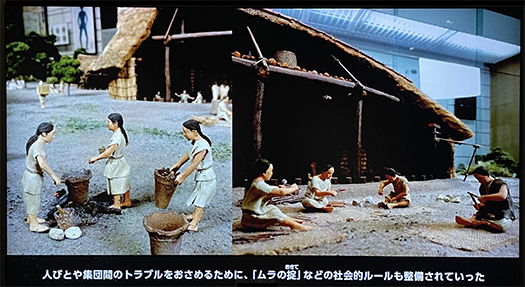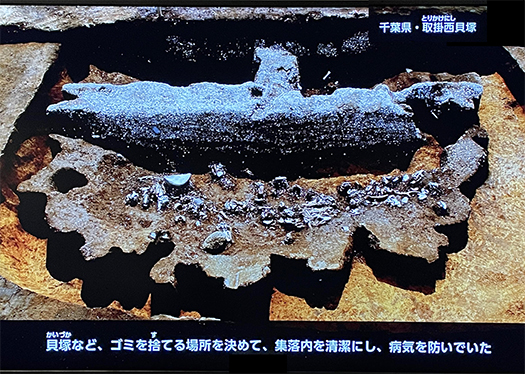


縄文の人類、その「社会」発展の様子の「見える化」。
その後、弥生以降の社会の基盤はこの1万年を超える縄文期が作った。
列島社会の精神史として考えるとその奥行きに戦慄する。
こういう領域に現代の探究が到達しつつあることが喜ばしい。
定住ということはそれ以前と以降を完全に分離するエポック。
国立歴史民俗博物館展示では従来、カンタンにしか触れられていなかった
この歴史段階について非常に革新的な探究がされている。
わたし個人で言えば、青年期に左翼思想の洗礼を受けたときのインパクト、
人類社会の科学的発展という基礎的な刷り込み「原始共産社会」
マルクス・エンゲルスが主唱したひとつの理想郷概念が
まったく「神話」にしか過ぎないことが「科学的に」解明されてきていると
受け止めることができたと思っています。
冷静に人類社会の発展経緯を考古的手法と炭素年代法を駆使して
解明して行くことでそういう「呪縛」から解放されていくのだと思います。
移動生活段階から定住がはじめられるとそれまでとはまったく違った
「社会」としての規則・ルールというものが自然に成立していった。
移動生活では「その場所から逃げる」という手段で解決してきた
「食糧の欠乏・ゴミ処理・伝染病対応・人間関係トラブル」などについて
社会としてしっかり対策していく必要性が高まって、
上の図のように、まずは土地利用のルール化が進展した。
食糧の備蓄機能の拡充、共同生活圏の創造であるムラ集落の出現。
ゴミ処理場所のルール化で伝染病対策も共同意思決定していった。
その発展に当たっては当然、移動生活段階での「知見」が大いに反映しただろう。
それまでは外界から目的への最適空間を「探す」という行為が主体だったものが、
より積極的に「自ら作り出す」という営為に置き換わっていった。
受動的環境適合から能動的な環境改変へのパラダイムシフト。

そのような営為の中から上のジオラマのようなムラが出現した。
「東京下宅部遺跡」の復元イメージ。東京都東村山市多摩湖町で展開された遺跡。
〜縄文時代後期晩期(約4,000から3,000年前)の遺構・遺物が数多く発見された。
川の流れ跡から木材を組み合わせた施設や多量の縄文土器や石器、丸木舟未製品や
丸木弓・飾り弓・木製容器、編み物の木製品、当時の食生活や自然環境を物語る、
シカ・イノシシの骨やトチノキ・クルミなどの植物が大量に出土した。〜
1万年以上の歳月をかけてこのような集落・ムラ社会を列島人類は創造した。
こういう生活圏形成の延長線上で次代の「農耕」弥生社会が受容されていく。
一方でこういう社会生活の中で統合の精神性とはいったいどうであったのか?
社会規範としての精神性、呪術や祭祀というものも強い根拠を持っていただろう。
祭政という一体の形而上規範が成立していったことも見えてくる。・・・
English version⬇
Settlement and the emergence of the Mura “code” 37,000 Years of the Japanese Archipelago – 18]
Rational solutions to food scarcity, garbage disposal, infectious disease response, and human relations problems. Land use planning and village rules. Visualization of Jomon. The Jomon Period.
Jomon humans, and the “visualization” of their “social” development.
Subsequently, the foundation of society after the Yayoi period was laid during this Jomon period, which lasted over 10,000 years.
The depth of the Jomon period, when considered as the spiritual history of the archipelago’s society, makes one shudder.
It is gratifying to see that modern exploration is reaching into this area.
Settlement is an epoch that completely separates the pre and post Jomon periods.
The National Museum of Japanese History exhibit is a very innovative look at this stage of history, which has traditionally been only touched upon in a cursory manner.
The exhibit at the National Museum of History and Folklore presents a very innovative exploration of this historical stage, which has been only briefly touched upon in the past.
For me personally, the impact of my baptism into leftist ideology in my youth, and the
The basic imprint of the scientific development of human society, “primitive communist society
The concept of a utopia, one of the main concepts advocated by Marx and Lenin, is nothing more than a “myth” at all.
I believe that it is now being “scientifically” elucidated that it is nothing more than a “myth” at all.
I believe that we are now able to accept it.
By calmly elucidating the development of human society using archaeological methods and carbon dating
I believe that we will be freed from such a “spell” if we continue to elucidate the development process of human society using archaeological methods and carbon dating.
I believe that we can free ourselves from such a “spell” by using archaeological methods and carbon dating to understand how human societies developed over time.
The rules and regulations of society were naturally established.
In the mobile life, the solution to the problem was to “escape from the place.
Food shortages, garbage disposal, infectious diseases, human relations problems, etc.
The need for society to take firm measures to deal with these problems has increased.
As shown in the figure above, the first step was to establish rules for land use.
The stockpiling function of food was expanded, and the “village community” emerged as a way of creating a communal living area.
Rules were established for garbage disposal sites, and communal decisions were made regarding infectious disease control.
Naturally, the development of the community was greatly influenced by the “knowledge” gained during the mobile life stage.
Until then, the main activity was to “search” for the best space for one’s goal from the outside world, but now, people are more actively engaged in “creating their own space.
The act of “searching” for the best space for one’s goal from the outside world until then was replaced by the more active act of “creating one’s own space.
A paradigm shift from passive adaptation to active modification of the environment.
The above diorama is the result of such activities.
The explanation was that it was a reconstructed image of the “Tokyo Shimo-Yakubu Ruins.
It is said to be a site that developed in Tamako-cho, Higashimurayama City, Tokyo.
〜The research to date has uncovered many remains and artifacts dating back to the late Jomon Period (approximately 4,000 to 3,000 years ago).
The remains of the river flow at that time revealed facilities made of wood, a large amount of Jomon pottery and stone tools, unmade round wooden boats, round wooden bows, decorative bows, and wooden bows and arrows.
Wooden products such as round wooden bows, decorative bows, wooden containers, and knitted goods, as well as bones of deer and wild boar, which tell of the diet and natural environment of the time, were also found.
Deer and wild boar bones and plants such as horse chestnut and walnut were excavated in large quantities. 〜The site has been in the area for more than 10,000 years.
Over a period of more than 10,000 years, the human beings of the archipelago created such settlements and village societies.
The next generation of “agricultural” Yayoi society was accepted as an extension of this kind of living area formation.
On the other hand, what was the spirituality of integration in this kind of social life?
Spirituality as a social norm, witchcraft, and rituals must have had a strong basis.
We can also see the establishment of a unified metaphysical norm of ritual government. …
Posted on 11月 18th, 2022 by 三木 奎吾
Filed under: 日本社会・文化研究, 歴史探訪







コメントを投稿
「※誹謗中傷や、悪意のある書き込み、営利目的などのコメントを防ぐために、投稿された全てのコメントは一時的に保留されますのでご了承ください。」
You must be logged in to post a comment.